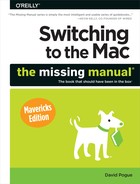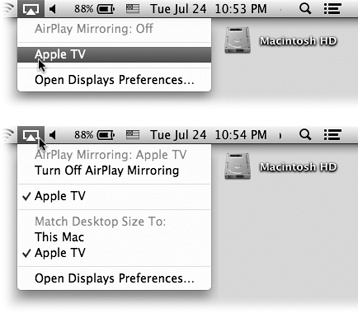If you’d shown this feature to the masses in 2005 or so, they’d have fallen down and worshiped it as a god.
Today, we’re used to wireless everything. But this is pretty cool: With one click, you can send whatever is on your Mac’s screen to your TV’s screen, in hi-def. No wires.
That stunt premiered on the iPad 2 and iPhone 4s. But on the Mac, AirPlay becomes far more useful. Now you can present photo slideshows on the TV from your laptop. Or play movies you’ve found online. Or give presentations from PowerPoint or Keynote. Or present software lessons to a class.
There is a catch, of course: This trick requires both a recent Mac model (mid-2011 or later) and an Apple TV. That’s a tiny, $100 black box that connects to a hi-def TV and lets you watch videos from services like YouTube, Netflix, MLB.TV, NBA, NHL, and Vimeo. It can also play videos, music, and photos from Macs or PCs on the network.
But with AirPlay, the Apple TV (and therefore your TV) can now play anything you can see on your Mac, including services like Hulu that aren’t available on the Apple TV alone. You can play your iTunes music while watching those cool screen-savery visualizers on your HDTV. And you can carry your $100 Apple TV around with you to corporate boardrooms to project your pitches, rather than a $1,500 projector.
Tip
The Mac and the Apple TV have to be on the same wireless network—but that doesn’t mean they need a WiFi hotspot. You may remember that your laptop can create its own WiFi network (see The Get Info method). This ad hoc network isn’t connected to the Internet, of course, but other gadgets can connect to it. So if you’re someplace without a WiFi hotspot, you can still use AirPlay. Just create an ad hoc network on your laptop, and then choose that as your Apple TV’s network!
Using AirPlay is so simple, it would confuse only an AirHead. See Figure 9-19 for instructions.
Once you turn on AirPlay, the AirPlay menulet lets you make an additional choice. A menu section called “Match Desktop Size To:” lets you choose either This Mac or Apple TV (or whatever you named your Apple TV).
Your Mac and your TV probably don’t have the same proportions and resolution. So the menu is asking: Which screen “wins”?
The factory setting is Apple TV. Your TV screen will be completely filled, although you might see black letterbox bars on your Mac’s screen. But if you’re watching TV shows or movies, for example, you won’t care.
Figure 9-19. Make sure the Apple TV is on the same WiFi network as your Mac. At that point, the AirPlay menulet appears automatically. Top: From it, choose the name of your Apple TV, and presto: Whatever is playing on your Mac simultaneously plays on your big screen, both stereo audio and 720p hi-def video. To stop sending your Mac’s A/V to your TV, choose “AirPlay Mirroring: Off” from the same menulet. Bottom: Specify which screen you want to impose its shape and resolution: the Mac or the TV.
If you choose This Mac instead, the picture will look normal on your Mac, but you might see black letterbox bars on the TV. That might be better for a PowerPoint or Keynote presentation, for example, where you want the TV to show exactly what the Mac shows.
Your choice here may affect the magnification of the image on your TV, too, since its resolution and your Mac’s probably don’t match.
In System Preferences→Displays, you’ll find an AirPlay Mirroring pop-up menu that duplicates the AirPlay menulet described above. You’ll also find a checkbox called “Show mirroring options in the menu bar when available.” That’s the on/off switch for the AirPlay menulet. When this option is turned on, and the Mac uses The Force to detect the presence of a nearby Apple TV, the AirPlay menulet appears automatically.
Not all Macs have the hardware horsepower to send video to an Apple TV; those made before mid-2011, for example, probably don’t. But even those Macs can still send audio to your Apple TV (or your AirPort Express base station), and from there to what’s presumably a better sound system than your Mac’s puny built-in speakers.
The official way to do that: Open System Preferences→Sound→Output. Click the name of the Apple TV or AirPort Express in the list of speakers.
But there are two faster ways:
Press Option as you open the
 menulet. The items in this menu magically sprout previously invisible choices—like Apple TV and your other AirPlay gear.
menulet. The items in this menu magically sprout previously invisible choices—like Apple TV and your other AirPlay gear.If you just want to play music that’s in iTunes, you can choose your Apple TV’s name (or AirPort Express’s name) from the pop-up button in the lower-right corner of the window.

